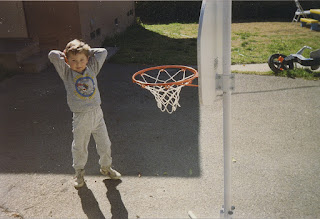1986 - 1988 --
Aggression, Throwing and Learning ---
I wish I knew (and at times I do) what could bring him to severe agitation one minute
and pure love the next.
 At
the age of three years old, Joshua was approximately the same age as a 12 to 18
month old. Later at the age of 15 years
(and many experiences later), he had progressed enough that he was the same age
level as a two to six year old. He could
say two to three word sentences, repeat the ABCs (with prompts) and count to 10
and sometimes even 20. With the help of
great school teachers, he had learned simple games on his computer — which he
absolutely loved He could draw a circle (or an “O”), a straight line (or an “l)
and was excited to draw and write more.
He loved to watch his favorite video tapes and/or TV programs, jumping
on the trampoline and playing any kind of ball game. However, he could not pedal or steer a bike,
or write his name, or do simple math.
At
the age of three years old, Joshua was approximately the same age as a 12 to 18
month old. Later at the age of 15 years
(and many experiences later), he had progressed enough that he was the same age
level as a two to six year old. He could
say two to three word sentences, repeat the ABCs (with prompts) and count to 10
and sometimes even 20. With the help of
great school teachers, he had learned simple games on his computer — which he
absolutely loved He could draw a circle (or an “O”), a straight line (or an “l)
and was excited to draw and write more.
He loved to watch his favorite video tapes and/or TV programs, jumping
on the trampoline and playing any kind of ball game. However, he could not pedal or steer a bike,
or write his name, or do simple math. I
was working full-time with two young sons, and a husband who was going through
school. Joshua was still in a
diaper. He did not always sleep through
the night, and he was an early riser.
Joshua did not understand so many things. He was aggressive, and he loved to throw
things. We bought him a miniature
basketball court so he could throw the ball into the net. He loved playing basketball, and he continued
to love throwing anything and everything.
He loved to play with people’s ears, and with his love of throwing, and
his love of ears, I could not wear earnings for a while as more than once my
earrings had been thrown across the chapel at church or just thrown somewhere.
I
was working full-time with two young sons, and a husband who was going through
school. Joshua was still in a
diaper. He did not always sleep through
the night, and he was an early riser.
Joshua did not understand so many things. He was aggressive, and he loved to throw
things. We bought him a miniature
basketball court so he could throw the ball into the net. He loved playing basketball, and he continued
to love throwing anything and everything.
He loved to play with people’s ears, and with his love of throwing, and
his love of ears, I could not wear earnings for a while as more than once my
earrings had been thrown across the chapel at church or just thrown somewhere.
 I
could not let go of Joshua’s hand in a public place or he would be in danger of
either running out into the street, or getting lost. I was in wonder at Jeremy, 2 years younger
than Joshua, who would walk obediently beside me at parks, stores, church,
etc., as I was constantly trying to keep hold of Joshua’s hand or if I lost it
for a moment, I was surely the next moment chasing him as he ran out of
control. For the rest of his life, every
day, was spent keeping Joshua safe, and happy, in countless and various ways.
I
could not let go of Joshua’s hand in a public place or he would be in danger of
either running out into the street, or getting lost. I was in wonder at Jeremy, 2 years younger
than Joshua, who would walk obediently beside me at parks, stores, church,
etc., as I was constantly trying to keep hold of Joshua’s hand or if I lost it
for a moment, I was surely the next moment chasing him as he ran out of
control. For the rest of his life, every
day, was spent keeping Joshua safe, and happy, in countless and various ways.
Joshua was like a hurricane, or tornado. Wherever Joshua went he can and did leave a trail of destruction. He could mess up a room faster than anyone I knew. He knocked things off of walls, pushed everything off the table, ripped wallpaper, spilled things and left his mark. At times it was intentional, and at other times he just didn’t realize that the ball he threw hit a certain picture on the wall or knocked something off the table. He would also grab me, Mike or his younger brothers and sister and hit them or scream and throw tantrums. A room could instantly change upon his presence. At other times, he could walk in a room and hug everyone and walk with his special walk and leave a trail of love. You never knew which trail you would get. I wish I knew (and at times I do) what could bring him to severe agitation one minute and pure love the next.


































